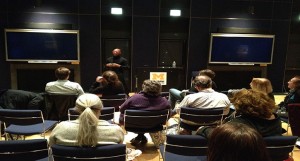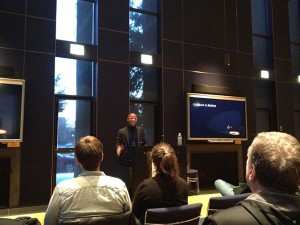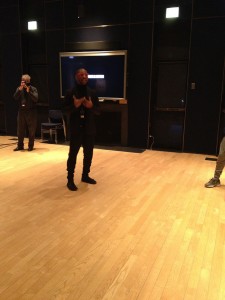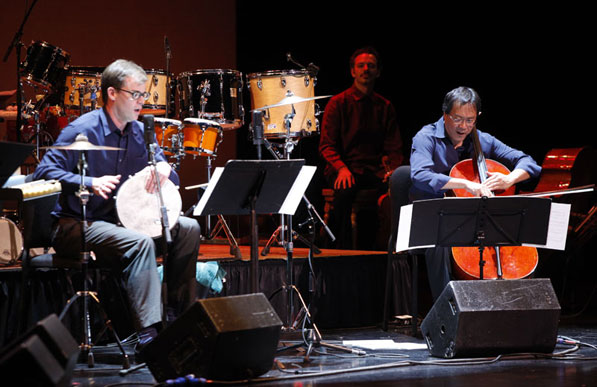UMS Night School: Curious About Dance – Session 4 Recap
Editor’s note: This post is a part of a series of by U-M student and UMS intern Hillary Kooistra, who’s covering our free UMS Night School: Curious About Dance workshop series.
Anything You Do Will Be Perfect
Welcome back, Night Schoolers! I hope everyone enjoyed their time off! The sun has been shining all week and it was certainly shining in the Alumni Center on Monday night. We were joined by Kyle Abraham, Founder/Artistic Director of Abraham.In.Motion (AIM): the company that will grace the Power Center stage this coming Friday and Saturday. Also with us was Matthew Baker, AIM choreographic associate/dancer, graduate of Western Michigan University, and Ann Arbor native. These two incredible artists invited us into the world of Abraham.In.Motion by demonstrating and talking about the company’s work, as well as allowing us to embody a bit of their choreographic process. Kyle, a MacArthur Award recipient and fascinating thinker/speaker/mover, confirmed an idea we have returned to each Night School session: dance is a thoughtful, collaborative and process-driven art form.
Kyle kicked off our session by showing us video clips of some of his work: Live! The Realest MC, Pavement, and the two works that his company will perform on Friday and Saturday: The Watershed and When the Wolves Came In. As we watched these intersections between stunning movement and innovative stage design, Kyle described the thought, research and collaboration behind the dances. We were then able to make informed, conceptual observations about each work while enjoying some incredible aesthetics. No wonder this man won a genius grant!
Kyle Abraham talks about his process before showing us clips of some of his dances.
After giving us a chance to see and hear about his dances, Kyle introduced us to the way he works with his company and let us experience his choreographic process with our own bodies. He led us through a few creative activities he uses to establish movement and choreography in collaboration with his dancers. Kyle is not one to simply enter a rehearsal with set material for his company to learn and replicate; his process-driven approach to choreography pays careful attention to the potential contributions of each individual body and mind in the room.
Kyle explains some of the intentions behind his process to a curious Night School cohort.
With these ideas in mind, we plunged into some AIM-motivated movement invention and exploration. First, we learned and practiced a simple arm gesture phrase (from The Quiet Dance, another work in his company’s repertoire).We executed this upper body sequence as we learned it, while letting our legs do whatever they wanted. We also explored a way to compose our own phrases by responding to “Action Words.” As Kyle (and fellow Night School Student Fred) prompted us to slice, jump, slide, squish, wiggle, and dive, we travelled across the room with our own sequences of movements and rhythms.
Night School students experience Kyle’s choreographic process: creating our own leg movements to accompany a set of arm gestures and travelling across the room in response to Action Words.
Kyle explained that the movement he and his dancers generate out of such tasks often becomes the starting point for phrases in his repertory works. In a third exercise dubbed “Catch What You Can,” he and Matthew demonstrated how one seed idea can blossom into a longer, lasting sequence. Kyle grooved to some music while Matthew followed behind him, trying to grasp as much movement as he could. Then Kyle instructed Matthew with prompts such as “left arm and leg chug back,” and “figure eight to the right,” as well as names of moves that seemed to have a significance within the company, such as “Classic.” Regardless of the prompt’s origin, Matthew remained on the same page as Kyle the entire time, and breezed about the floor as he constructed his phrase. The result was amazing. From Kyle’s few moments of visual and verbal cues, Matthew danced an entire phrase of movement without stopping to think once: leaving us asking, “Did that just happen?”
Abraham.In.Motion dancer Matthew Baker develops a sequence of movement by “catching what he can” of Kyle’s visual and verbal cues
Once we picked our jaws off the ground and Matthew got a chance to catch his breath, we sat back down for a conversation with the two artists. Kyle provided generous answers to our questions about his company and process, sharing insights about the shifting roles of dancers and choreographers, the value of time in choreographic development and honesty in performance, and the approach to working with new bodies while creating work on others. I must be getting early onset nostalgia as we approach our final Night School next week, because I could not help but recall all the lessons we’ve learned this semester as I heard Kyle speak about his work. Remember the exercise we did with Martine a couple of weeks back, where we had to remember our partner’s gestures as they told us “something nobody knew”? I thought of that session throughout Kyle’s “Catch What You Can.” How Charles helped us alter gestures so they would fit the two-dimensionality required by labanotation? Very similar to how Kyle revealed he will develop a gesture until it has traces of its origin but breathes a new life.
If there’s one thing I think we’ve all learned through Night School this year, it’s that there are many, many entryways into making, viewing, and discussing dance. We’ve had the privilege of unfolding these multiple layers throughout the weeks: questioning why plastic bags float in the air, how people walk on walls, or where Kyle Abraham finds his musical inspiration. But more time for reflection next week. This week, we have a marathon of events related to Kyle’s residency to look forward to! Remember, Friday and Saturday will showcase two different programs, so why not buy two sets of tickets and camp out at the Power Center this weekend? You can even stay an extra night and be fed bagels on Sunday at the first ever UMS Brunch Download Conversation. Hope to see everyone this weekend, and at our LAST session/graduation next Monday night! In addition to thinking about the UMS dance season still to come, we will be celebrating with our Adventure Card raffle drawing, Perfect Attendance Awards, and of course, some food and drinks. So don’t miss out! No cap and gown necessary, just your presence and energy.
Upcoming Events:
Abraham.In.Motion Performances, Mar. 13-14, 8pm, Power Center (TICKET REQUIRED)
Related:
Mar. 13: Opening Night Q&A: Abraham.In.Motion, Power Center, post-performance (TICKET REQUIRED)
Mar. 14: You Can Dance: Abraham.In.Motion, Ann Arbor YMCA, 1:30-3pm (FREE – SIGN-UP REQUIRED, BEGINS AT 12:45PM, FIRST COME FIRST SERVE)
Mar. 14: Closing Night Q&A: Abraham.In.Motion, Power Center, post-performance (TICKET REQUIRED)
Mar. 15: Brunch Download with Kyle Abraham, U-M Alumni Center, 11am (FREE)
Session 4 Resources:
Kyle Abraham/Abraham.In.Motion, Live! The Realest MC Promotional Video
Kyle Abraham/Abraham.In.Motion, Pavement Promotional Video
Kyle Abraham/Abraham.In.Motion, The Gettin’ Promotional Video
Q&A with Percussionist Joseph Gramley
Multi-percussionist Joseph Gramley is a professor of music at the University of Michigan and will be appearing as a guest artist with the Pavel Haas Quartet on April 18th in Rackham Auditorium. Gramley’s dynamic and exciting performances as a soloist and as a member of Yo Yo Ma’s Silk Road Ensemble has generated enthusiasm from emerging composers, percussion aficionados, and successful ensembles around the world.
Kari Dion is a U-M Master’s Clarinet student and UMS Digital Media Intern.
Kari Dion: When did you first start collaborating with other established ensembles?
Joseph Gramley: When I was a freshman at UM, I was selected to join the Spoleto festival orchestra in both Charleston, SC and Spoleto, Italy. There, I was asked to collaborate on the chamber music series and the Music In Time series, all with established ensembles. Then, upon my arrival to New York for study at the Juilliard School, I continued to collaborate — at the Juilliard, with NYC ensembles and as a guest artist for the Marlboro Music Festival in Vermont, where in 1993, I was asked to perform the Bartok Sonata for two pianos and percussion with Andras Schiff and Bruno Canino. My schooling at UM and Juilliard with such great teachers as Michael Udow, Salvatore Rabbio, Daniel Druckman and Gordon Gottlieb taught me the importance of collaboration. All of my mentors embraced collaboration.
KD: As a percussionist, is collaboration with other artists easier or more challenging? Have you collaborated with a string quartet before? Are there other notable ensembles that you have collaborated with?
Joseph Gramley: As a founding member of the Silk Road Ensemble with Yo-Yo Ma, I’ve been lucky enough to collaborate with many string ensembles. This includes, Yo-Yo Ma and the full ensemble of artists of the Silk Road Ensemble, Brooklyn Rider, and the Knights. Since 1993 I’ve been a regular performer at the Marlboro Music Festival which is based solely around collaboration and chamber music. I’ve collaborated with Dawn Upshaw and Bright Sheng in concerts and opera performances. For many years, I’ve been associated with Carnegie Hall and have performed concerts at Zankel with David Robertson, George Benjamin, Sofia Gubiadulina, and many others. For the World Expo in Nagoya Japan in 2006, I was lucky enough to be asked to perform the Chen Yi “sound of the five” on marimba with the silk road ensemble string players Nick Cords, Colin Jacobsen, Mike Block and Johnny Gandelsman.
KD: What do you enjoy most about collaborating with other ensembles?
Joseph Gramley: Collaboration is my oxygen. I really do need it to survive. It’s what I love the most. The communication, the trust, the communal goal, the support. You can’t get much better than a highly communicative chamber music performance.
KD: What is your role when you are playing with a string quartet? How much time will you have to rehearse with the Pavel Haas Quartet prior to the performance?
Joseph Gramley: My role with a string quartet will mimic my role with any group that I collaborate with. It’s about trust and communication. We’ll find what’s important in the musical composition to each of us and, through trust and communication, we’ll hope that the audience has a transformative experience.
KD: What was your favorite musical collaboration?
Joseph Gramley: That’s hard to say; to choose one would place all of my amazing colleagues in second place…..As I’ve noted in this interview, which by the way, has GREAT questions, it’s all about the communication and message. Of course, I can’t continue without mentioned one of my most influential mentors: Yo-Yo Ma. What an angel and a saint. He embodies everything that is right about music, chamber music, and the arts.
KD: Aside from your performing career, you are also a professor of percussion at U of M. How does teaching supplement or enhance your performing experiences, or vice-versa?
Joseph Gramley: If you attend UM Football Games and stay to hear the incredible UM Marching Band, you’ve heard the phrase, “You can’t have one with out the other.” This is in reference to two great ‘hits’ for the band that are always performed back-to-back. The same goes for my teaching career vis-a-vis my performing career. They really do go hand in hand. When I tour, I come back to UM so incredibly enthusiastic about my teaching and our great students here. When I’m on tour, I’m always referencing my students. In fact, my colleagues in the Silk Road Ensemble kid me a lot for writing emails to the studio at UM talking about what I’ve been learning. It inspires me to perform as equally as it does to teach….one informs the other.
KD: Is musical collaboration something that you emphasize to your own students at U of M? Are there important collaborations your students have been a part due to your influence?
Joseph Gramley: Most definitely! I stress it everyday at UM. I tell my students, “This is what we do, we collaborate.” There are but a few ‘solo’ percussionists in the world and they too have a collaborative element to their careers.
KD: You have so many elements to your career. Which do you find most rewarding?
Joseph Gramley: Tough call! One of my goals is to give 100% to whatever musical and collaborative situation or aesthetic that I may find myself in. I stress this with my students as well. Whether it be a ‘command performance’ where I’m called upon to perform works chosen by other artists, or a musical situation fully produced by myself, I firmly believe that we have to “leave it all out there on the court.” To be honest, the most rewarding elements are the ones that combine to form the sublime, transformative experiences. Experiences of which that it is my duty to include the audience in.
KD: What music inspires and influences you? We’ve been asking our interviewees to share a few musical suggestions with our audiences. Can you share 3 to 5 pieces or songs that you connect with?
Joseph Gramley: The Chen Yi Percussion Concerto is one of my new favorite works. Evelyn Glennie has recorded it, and I’ve been lucky enough to perform it with Kenneth Kiesler and the UM USO, as well as GianCarlo Guerrero and the Nashville Symphony.
Osvaldo Golijov’s ‘Air to Air’ commissioned by my group, the Silk Road Ensemble, is one of my all-time faves. It’s on our last album: OFF THE MAP.
Anything recorded by BROOKLYN RIDER is amazing. Especially Colin Jacobsen’s works and the full groups joint commission: SEVEN STEPS.
Student Collaborations at The Kennedy Center
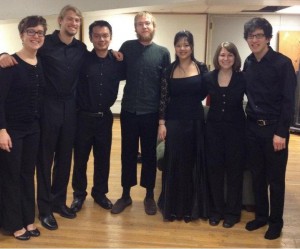
From Left to Right: Martha Cargo, Jordan Brooks, Eric Siu, Erik Haasler, Rimbo Wong, Kari Dion, Lee Dionne.
A few weeks ago, I traveled to Washington D.C and had the pleasure of playing with musicians spanning the entire country. The University of Michigan participates annually in the Kennedy Center’s conservatory project, for which college students from around the country are brought together to collaborate.
This year, Three Cities Marathon project showcased new and contemporary music from recent composers. I was ecstatic to be U-M’s nominee this year; I had always admired the Kennedy Center’s commitment to young artists, but I never thought I would get to be a part of it.
I had never been to Washington D.C before, so after I arrived, I immediately wanted to see the sights. I walked around Georgetown and through the monuments, admiring the city. Finally on Saturday morning, I met and rehearsed with my fellow student musicians from around the country.
The piece I was invited to perform was Martin Smolka’s Die Seele auf dem Esel (The Sole on the Donkey) for Piccolo, Eb Clarinet, Cello, Viola, Violin, Percussion, and Piano; non-traditional as far as instrumentation goes.
The piccolo player was Martha from Manhattan School of Music, the cellist was Erik from San Francisco, Rimbo was the violist from the Cleveland Institute of Music, the violinist was Eric from Rice, the percussionist was Jordan from Berkley, and the Pianist was Lee from Yale. Seven extraordinary musicians, yet, our piece was very hard to put together.
When modern music is notated, it tends to be more ambiguous and exceedingly more complicated metrically, making rehearsal’s very difficult. My part actually instructed me to play certain notes however I wanted to, for any duration, until the “rain stick” decided to stop. So crazy!
We had very little time to put the piece together; the rehearsals were Saturday, and the performance was Sunday afternoon. But, despite the complicated notations and the shortness of the stay, the performance was a wonderful experience. Having the pleasure to play with such great musicians who have the ability to hear and react perfectly to everything was very special.
The other composers featured on the concert were Johannes Maria Staud and György Kurtág. Probably the most memorable piece from the whole concert was Strad’s work Incipit II for trombone and bass drum. This seems fairly normal, however, Strad’s piece is meant to be played by one person. The performer is instructed to play a kick drum, the trombone, as well as scream and grunt during the piece. It was one of the most involved solo works I had ever heard; it was brilliant!
Playing Eb clarinet has always been very fun for me, but I had never imagined it would take me so many different places. Being part of the Three Cities Marathon project was especially fun. Seeing a new city, performing new music, and connecting to more wonderful musicians; thanks so much U of M for the opportunity.
Check out the link to the performance!
— Kari Dion is a U-M Master’s Clarinet student and UMS Digital Media Intern. She is also part of Akropolis quintet.


